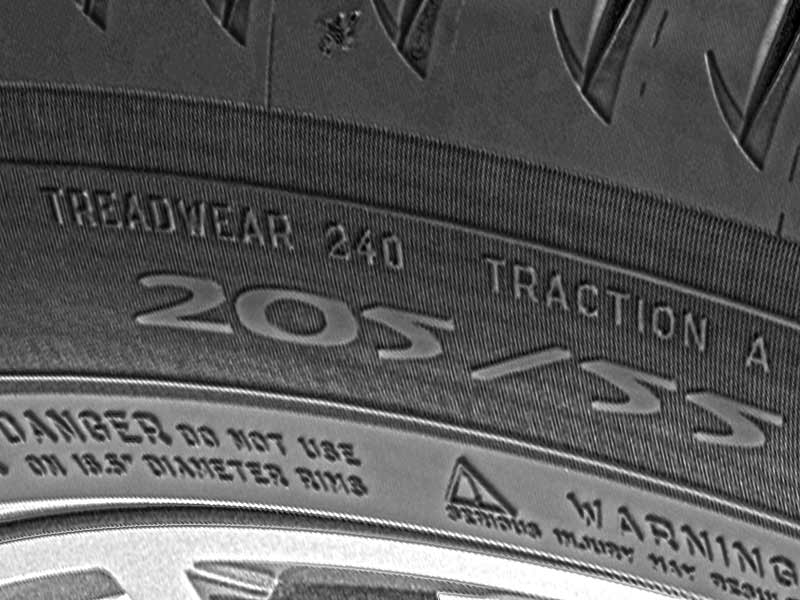UTQG Rating Meaning: UTQG grading is a standard way to grade treadwear, traction, and temperature. Tires are assigned specific ratings on the basis of their treadwear resistance, traction qualities, and temperature endurance abilities according to a standard scale.
Table of Contents
What is UTQG?
UTQG is the abbreviation of “Uniform Tire Quality Grading”, developed by the U.S. Department of Transportation (DOT).

It gives information about the temperature, traction, and tread wear rating of tires and provides the customers with a yardstick to measure and compare the performance of the different tires.
Quality tests for UTQG rating are performed by Tire Manufacturers or by a third party (testing company).
Then results are reported to DOT which reassures and assigns the respective ratings.
UTQG rating includes treadwear, traction, and temperature grading. It is indicated on the sidewall of the tires in the form of words and grades.
This rating is not required for winter / snow tires, temporary tires, trailer tires, light truck tires, and tires having less than 12 inches in diameter.
Treadwear rating
Treadwear grading demonstrates the service life of a tire, it ranges from 100-1000.
It tells how long a tire can be used.
The higher number of treadwear rating means that the tread takes more time to wear down and the service life of the tire is more.
For example, the longevity of the tire with a 600 UTQG rating is double than the tire having a 300 UTQG rating.
Traction grading
Traction rating describes the performance of a tire in wet conditions, it may be AA, A, B or C.
AA means the tire provides the best traction while C indicates that tire performance is least in rainy weather.
This rating expresses the ability of the tire to stop the vehicle at a short distance when the brakes are applied in grades.
A tire having an AA wet traction rating stops much more quickly than a tire with a C rating.
Temperature grading
Temperature rating describes the heat resistance offered by a tire while driving the vehicle at high speeds.
The tires are tested under specific conditions in the laboratory and graded comparatively.
Temperature is graded as A, B, and C, while C is the minimum heat resistance level that a tire can have for safety measures.
If a tire cannot minimize the production of heat or it has poor heat dissipating ability it will lead you to safety hazards.
As high temperature for a long time for example you are driving on a long journey in hot weather, deteriorates the rubber of the tire tread.
Resultantly, the tread wears rapidly and reduces the life of a tire.
And if the temperature rises above a certain limit it will lead to sudden tire failure.
A tire is capable to support a vehicle at high speed if its temperature tolerance ability is good. The tires having an A grade work at high speed than the tire graded as B and C.
UTQG Testing
These ratings are based on laboratory tests under specific conditions and are described by comparing with a control tire.
However, the relative performance of tires may vary according to the road conditions and driving habits.
Treadwear testing
For evaluating and grading tread performance, NHTSA (National Highway Traffic Safety Administration) designed a test track of 400 miles. A reference tire is used whose tread wear rating is 100 and all the tires are graded in accordance with the reference tire.
The tires are driven for 7200 miles under specific conditions, wear is measured after the experiment, and if the tested tire wear four times slower than the reference tire then a 400 rating is given to the tested tire.
But treadwear grading does not tell you about the tire mileage as it only explains the worn out time of the tire in comparison with the control tire.
Traction Testing
NHTSA develops asphalt and concrete skid pads for testing the wet traction of tires.
The tires which are being tested are fitted on a skid trailer then the skid trailer is pulled by a truck at a speed of 40 mph over the testing surface.
Water is sprayed on the road ahead of the vehicle just before applying the brakes and instruments measure the coefficient of friction when the brakes are locked temporarily and the wheel is skidding.
The tire’s performance is compared with the control tires and graded accordingly.
| Grades | Wet traction of tires |
| AA | Superior |
| A | Good |
| B | Average |
| C | Poor |
Traction rating is measured on straight roads so, the traction offered by the tire when your vehicle is taking a turn is not included in traction grading.
Temperature testing
For evaluating the performance of tires, inflated tires are tested against a high-speed drum and graded accordingly.
| Temperature Grades | Speed |
| A | Above 115 mph |
| B | 110 to 115 mph |
| C | 85 to 100 mph |
Summary
- UTQG is a standard way of grading treadwear, traction and temperature tolerance of the tires.
- It is represented on the sidewall of tires.
- The treadwear grading describes how long a tire can last in comparison with a specified standard tire.
- The traction rating provide information that whether a tire provides good or poor grip on a wet road.
- The maximum speed at which a tire can be derived is explained through the temperature grading.
